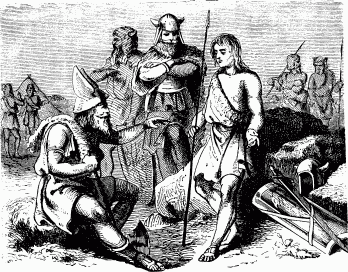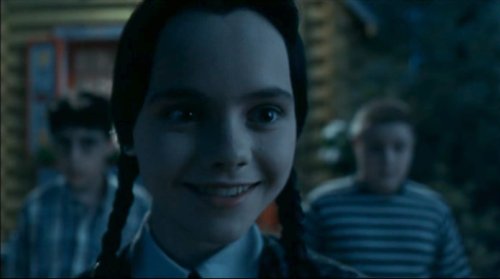|
Goth: A Brief IntroductionWhat mental picture does the word "goth" evoke? Perhaps you imagine an acne-ridden teenager, with bad posture and a slight pudge, traipsing around the mall in an oversized black t-shirt. Or you think of certain movies, like Beetlejuice But whatever you picture, a quick mental survey will show you just how diverse goth culture (or dark wave culture, as it's sometimes called) actually is. From Nick Cave to Morticia Addams, this subcultural style has evolved while retaining its individual character. The label "goth" has taken on a pejorative tinge. Few people––even homicidal maniacs––want to be associated with it. However, it's a descriptive moniker, for a unique and creative subculture, and need not be pejorative. This article explores gothic culture as it relates to style. I'll start with culture and work towards style, as an expression of philosophy. What Does "Goth" Mean?
The Goths were an East Germanic tribe, perhaps from modern-day Sweden. They invaded the Roman Empire many times between the 3rd and 5th centuries C.E. Because of these invasions, and their unusual culture, "goth" became synonymous with "barbaric." During the European Renaissance, cathedrals like Notre Dame, Chartres and Bad Doberan were considered barbaric and uncivilized. The appellation "gothic," then a synonym for "barbaric," stuck. Over the course of centuries, the word's meaning transmuted to mean the gloomy, mystical aesthetic of these buildings. Authors like Mary Shelley, Horace Walpole, Bram Stoker and Edgar Allan Poe experimented with this aesthetic, creating what we now know as horror fiction. These writers emerged from the Romantic movement, which emphasized emotion and passion, especially gloomy and doomed passion, over logic, reason and sunny optimism. Mary Shelley, for example, was the wife of Percy Bysshe Shelley, romantic poet and contemporary of Byron and Keats. Fast forward to 1979. After punk burnt itself out, UK post-punk bands like Bauhaus and Siouxsie and the Banshees emerged with a darker, more introspective sound. These bands were called "dark wave," "punk gothique," "new romantic" or just "post-punk," as many diverse groups were then called. These bands borrowed heavily from the punk and new wave traditions of music and dress: early photos show lots of red lipstick, black leather, torn fishnets, even army boots. It wasn't until the early 1980s that "gothic" was recognized as a distinct subculture. Clubs like "Batcave" in London created visibility for this nascent scene; early goths were sometimes called "Batcavers," and an early Birthday Party song, "Release the Bats," parodies the "bat horror vampire" aesthetic. In the 1990s, new minicultures and sub-subcultures emerged; the label "goth" became more contentious, as performers like Rammstein, Nine Inch Nails and Marilyn Manson drifted into the mainstream. These contentions were parodied, quite successfully, by Jhonen Vasquez in the book Johnny the Homicidal Maniac. Music
Most early goth bands came from the UK. A similar but distinct movement, called No Wave, emerged concurrently in New York City. After 1983, No Wave was no more, and the prominent members in the scene, such as James Chance, Lydia Lunch and Thurston Moore, moved on to other projects. Traditionally, the goth movement's "birth" is marked by Bauhaus's release of "Bela Lugosi's Dead" in 1979. The song was used for the cult vampire film the Hunger, shown below. Later bands, such as the Cocteau Twins and Dead Can Dance, eschewed punk rock for a more dreamy aesthetic, while death metal bands combined monochromatic fashion with heavy metal music. The "New Romantics," like The Cure's Robert Smith, wore poet's shirts, dark jackets and tight pants. Industrial artists, such as KMFDM, incorporated PVC, Vinyl, straitjackets and other artificial elements into their wardrobes. The popularity of gauged piercings among industrial fans earned them the nickname "rivetheads." Films
Old horror films, like The Cabinet of Dr. Caligari Campy 1950s and 60s horror films also added to the aesthetic; tv personalities like Vampira and the Addams Family (later remade into a movie) played on the spooky aesthetic. In the late 80s and early 90s, movies like Interview with the Vampire Tim Burton is probably the best-known director of these features, with titles like Beetlejuice, Edward Scissorhands and The Nightmare Before Christmas in his repertoire. Philosophy: "Always Look on the Dark Side of Life"Sorrow, pain, even violence are all part of the human condition. Rather than being eternally perky and optimistic, goths favor finding beauty and even joy in darkness. Otherwise, how can you be considered fully alive? This doesn't mean cultivating an air of being "studiously aloof." It's more important to express your true self, even if your true self is quite pretentious. Western culture is too materialist/conformist/vulgar, and we should return to the elegance/depravity/poetry of a bygone time, or at least create a more enriching alternative to the mainstream. Related Reading: All Goth Articles, sorted by subcategory Common Misconceptions About Goth Culture Return to our subcultures section. Return to Enjoy Your Style's home page. Search our site: |
Search this site:







